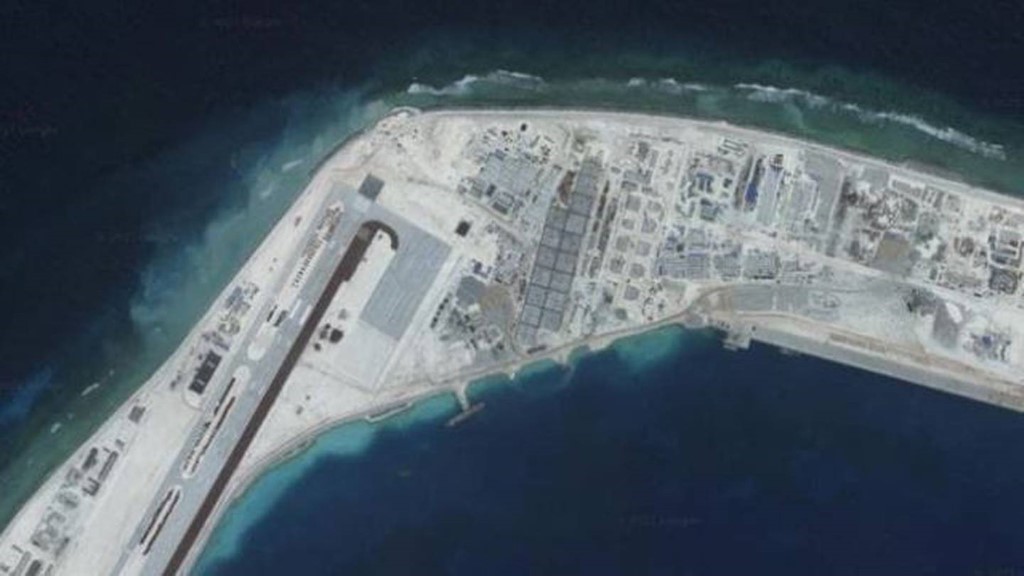In today’s Money Morning…today’s piece has a bit more of a geopolitical bent…China digging in…trust me, it’s an eye-opener…and more…
Dear Reader,
While yesterday’s piece was focused on copper prices and the macro picture, today’s piece has a bit more of a geopolitical bent.
Let’s start out with this this rather disconcerting photo…
|
|
| Source: News.com.au |
It’s new satellite imagery of what China is up to on its controversial artificial islands in the South China Sea.
A few years ago, these were just islands and the odd airstrip, where there used to be just sea.
Now it appears they are full-blown military bases.
As the New Zealand Herald reports:
‘A report by geospatial software company Simularity has revealed what appears to be infrastructure for radars, antennae mounts and what could be a potential military base on Mischief Reef.
‘Classified as an atoll — a ring-shaped coral reef — located 250km from the Philippines, the landmass has been occupied and controlled by the People’s Republic of China since 1995.
‘The images show the construction in seven areas between May 2020 and February 2021.
‘Another shot also shows a concrete structure with a spherical radome — a weatherproof enclosure used to protect a radar antennae — cover nearby. Simularity states this could “possibly be a fixed radar structure“.
‘Other sites are still mid-construction or have been cleared for further development.’
China digging in
‘Dr Jay Batongbacal, Director of the Institute for Maritime Affairs Law of the Sea in the University of the Philippines, says the new infrastructure suggests China is digging in.
‘“They’re basically adding on survey lens equipment, apparently radars — there’s already a lot of them in the reef in the first place,” he told Philippine broadcaster ANC.
‘“The addition of new radars appears to indicate they’re really expanding the capabilities of this artificial island. And then the fact it is continuing despite everything that has been going on in the rest of the world, it really indicates the intention of China to really fully develop these artificial islands into full-blown military bases.”’
[conversion type=”in_post”]
It’s unnerving. And it could be the start of a trend to greater militarisation of the geographical space between Australia and China.
Point is, it’s important to be aware of these strategic shifts.
Just as economics and markets intersect at key junctures, so too do big geopolitical moves.
So why did I choose to share with you this image?
Well for context, I grew up a massive fan of military history, I studied all the major battles, the generals, the tactics.
It was absolutely fascinating, to me at least. And it’s a shame it’s not really taught in schools anymore.
The sugar-coating of history has an array of consequences.
First of all, it leaves an impression on children that nothing ever bad happens or did happen in our Western bubble.
Perhaps worse, is that it can inculcate students (and future investors) with a naïve view of the strategic landscape.
But geopolitics is not really our beat here at Money Morning.
And I’m a small-cap oriented analyst anyway.
I brought it up because the moves in the South China Sea are one of the topics covered in Jim Rickards’ new book, The New Great Depression: Winners and Losers in a Post-Pandemic World.
China’s increasingly bellicose presence in the South Pacific…the origins of the virus…its moves in the Taiwan Strait leading to a warmer Cold War with the Biden administration…and its ongoing standoff with Australia…
All of these are going to be big factors in what Jim Rickards and Nick Hubble (author of the book’s exclusive Australian chapter) call the ‘Long COVID Decade’.
‘“What if the narrative we’ve held for decades — of China’s rise being good for Australia — is wrong?” asks Hubble.
‘What if the geopolitical risks are far larger than we presumed?
‘What if our economy is now reliant on a belligerent force that seeks to punish us more than promote the economic interests of its own citizens?
‘2020 gave us the first hints that we should be worried. First it was the Uighurs. Australian organisations played a key part in exposing the ongoing alleged genocide in Xinjiang. They demanded investigations and transparency.
‘Then it was questioning China’s story on COVID-19. Australia’s government demanded investigations and transparency.
‘Unfortunately, the only investigations and transparency we got was of our own armed forces. And that exposed something rather ugly.
‘Incidentally, I briefly knew an Australian solider who actively used torture in Afghanistan. I met him when he was dealing with the personal consequences afterwards. So the recent discoveries were no surprise to me.
‘As shameful as some actions in Afghanistan were, I think we should feel proud about Australia’s willingness to stand up to China. The question is: What will it cost us…?’
Look, I really do encourage you to read the exclusive Australian edition of The New Great Depression if you haven’t already.
As I say, it comes with a specialised, Australian investor focused chapter called ‘Long COVID Decade Australia: What happens next, how to prepare’.
Trust me, it’s an eye-opener.
Neither Jim nor Nick mince their words.
And, while you may not agree with all their conclusions, forecasts, and investment strategies, you’ll be smarter after you finish it.
The Financial Times calls Jim and Nick’s new book a ‘bracing collection of salvos,’ and the two authors are scathing in their assessment of the global response to the pandemic.
What’s more, they’re pretty darn forthright about where it’s going to lead us.
Regards,
 |
Lachlann Tierney,
For Money Morning
Lachlann is also the Editorial Analyst at Exponential Stock Investor, a stock tipping newsletter that hunts for promising small-cap stocks. For information on how to subscribe and see what Lachy’s telling subscribers right now, please click here.



Comments